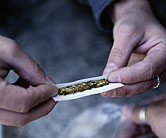
MONDAY, May 12, 2014 (HealthDay News) — College guys are more than three times likelier to smoke marijuana and drive than they are to drink and drive, a new study finds.
About 44 percent of college-age men reported driving while stoned during the previous month, compared with only 12 percent who said they drove after drinking, researchers report in the May 12 issue of the journal JAMA Pediatrics.
“We definitely need to think about how to help students understand that marijuana is risky to use before you drive,” said study lead author Jennifer Whitehill, an assistant professor at the University of Massachusetts, Amherst, School of Public Health and Health Science. “These are young, inexperienced drivers, and marijuana does increase crash risk.”
College women are less likely to drive while stoned, with only 9 percent getting behind the wheel after marijuana use, the study found.
However, 35 percent of the women admitted to riding with a driver who had been smoking pot. About 51 percent of men had been a passenger who rode with a stoned driver.
The researchers also found that for every 1 percent increase in the number of friends who use marijuana, there’s a 2 percent increase in the risk of riding with a stoned driver.
Nationally, marijuana is involved in 12 percent of all fatal crashes among 16- to 20-year-olds, the researchers reported in background information. The combination of substance use and inexperience behind the wheel increases the risk of a wreck.
“The findings of this study are worrisome because we know that both alcohol and drug-impaired driving is incredibly dangerous — and both are 100 percent preventable,” said Jan Withers, national president of Mothers Against Drunk Driving (MADD).
“It’s important that parents communicate openly with their kids about not drinking before age 21 and the dangers of underage drinking, which can lead to other risky behaviors like driving after drinking or drug use, or getting in the car with someone who’s substance-impaired,” Withers said.
The researchers analyzed data from an ongoing study of 315 students at two large state universities in Wisconsin and Washington. Students were asked whether they had used marijuana or alcohol in the previous 28 days, and whether they have driven under the influence or were a passenger in a car driven by someone who was drunk or stoned.
Overall, 30 percent of male and 13 percent of female respondents said they had used marijuana in the 28 days prior to being surveyed, while 67 percent of the men and 64 percent of the women reported using alcohol over the same period.
But marijuana users were much more likely to drive under the influence. While 44 percent of men and 9 percent of women reported driving while stoned, only 12 percent of men and 3 percent of women reported driving after drinking.
There doesn’t seem to be the same social stigma about driving stoned that there is about driving drunk, said Mark Asbridge, an associate professor at the Dalhousie University Department of Community Health and Epidemiology, in Halifax, Canada.
“We’ve got to think about the kind of techniques that were effective for drinking and driving and how they might be applied here,” said Asbridge, who wrote an editorial that accompanied the study.
Those tools include strict laws against driving under the influence, strong law enforcement efforts, and a public education campaign, he said.
Unfortunately, a tool such as a Breathalyzer has not yet been developed to help police officers determine on the fly whether a person is driving stoned, Whitehill and Asbridge said.
Police now have to rely on blood or urine tests to determine whether a driver has been using marijuana, and that requires bringing the person to the police station. A saliva test used by Australian police has been found to have accuracy problems, Asbridge said.
It’s important that public officials start taking steps to curb driving while stoned, given that two states — Colorado and Washington — have legalized recreational marijuana use for adults, and another 14 states have decriminalized marijuana possession, Whitehill and her colleagues said.
“As more and more states are making marijuana more available, it’s important to say that it comes with these risks related to vehicles,” Whitehill said. “With alcohol, we’ve seen great reductions over time due to public policies and public education. In the states that have recreational marijuana, everyone’s trying to figure out policy solutions around this.”
More information
For more on drugged driving, visit the U.S. National Institutes on Drug Abuse.
Copyright © 2025 HealthDay. All rights reserved.

